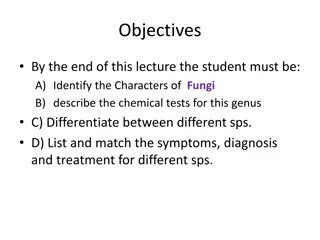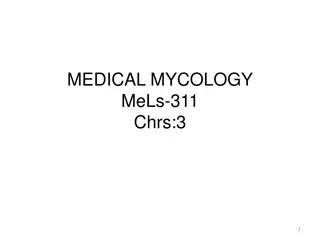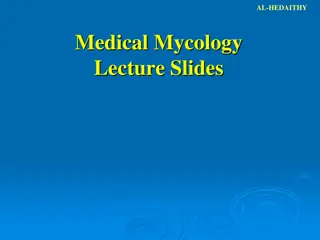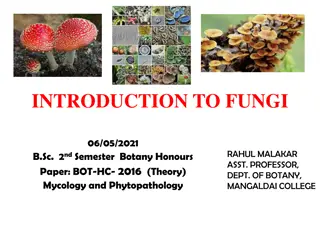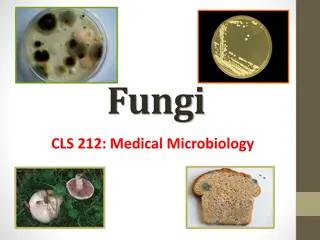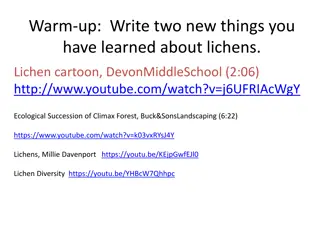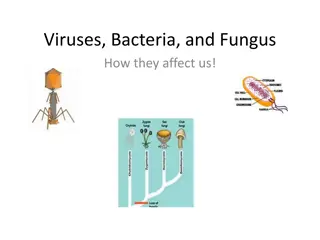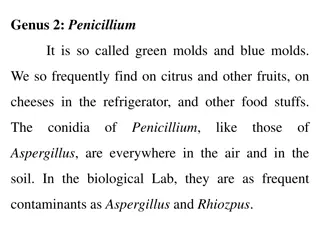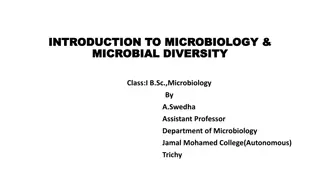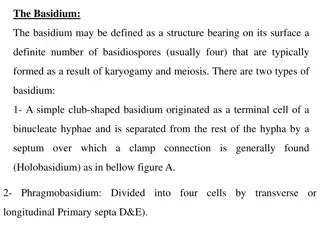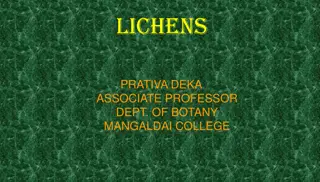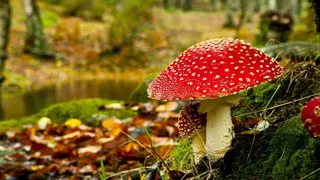Understanding the Fascinating World of Fungi: Mycology Insights
Explore the realm of fungi through the lens of mycology, delving into their diverse characteristics, including their eukaryotic nature, heterotrophic lifestyle, and impact on various ecosystems. Discover how fungi play crucial roles as saprophytic, symbiotic, or parasitic organisms, influencing food production, biodegradation, and even medicinal advancements. Uncover intriguing details on their classification, such as the phylum Ascomycota, and learn about fascinating species like Armillaria mellea, the largest living microorganism on Earth. Dive into the unique traits of fungi, from their lack of chlorophyll to the complex structures of hyphae and mycelium.
Download Presentation

Please find below an Image/Link to download the presentation.
The content on the website is provided AS IS for your information and personal use only. It may not be sold, licensed, or shared on other websites without obtaining consent from the author. Download presentation by click this link. If you encounter any issues during the download, it is possible that the publisher has removed the file from their server.
E N D
Presentation Transcript
Fungi CLS 212: Medical Microbiology
Mycology: the study of fungi Characteristics Prokaryotic cell Eukaryotic cell Primitve nucleous One or more true nucleus Nucleus Characteristics of fungi: All fungi are Eukaryotic organisms Arranged in chromosomes Genetic material Circular DNA 1. Size of cell Usually smaller Usually larger Contains peptidoglycan No peptidoglycan Cell wall Simple binary fission Mitosis and Meiosis Division
General Characteristics of Fungi The study of fungi is called: Mycology. 1. All fungi are Eukaryotic organisms living everywhere on earth. 2. Fungi are Heterotrophic i.e. depend on other organism for food and are different from plants which are Autotrophic . Heterotrophic organisms are 3 kinds: A) Saprophytic: the fungus is living on dead organic matter. B) Symbiotic: the fungus is living together with other organism. C) Parasitic: the fungus is living in an organism and it is harmful to it e.g. Candida albican. 3. Beneficial fungi are important in the production of cheeses and antibiotics e.g. Penicillin.
General Characteristics of fungi 4. Fungi also live on unlikely materials. Affect plastic and leather and spoil some food like jams, pickels,.. 5. They are not plants. PLANT FUNGUS PIGMENTS Chlorophyll for photosynthesis No pigments CELL WALL Contain Cellulose Contain Chitin 6. Most of Fungi are microscopic but some can be seen by naked eye.
Armillaria mellea The biggest living microorganism in the world is a fungus called: Armillaria ostoyae of the species Armillaria mellea
Characteristics of fungi:continued 7. Do not contain chlorophyll (Non photosynthetic) 8. Release digestive enzymes to break down organic material or their host 9. Lack true roots, stems, & leaves 10. Grow as microscopic tubes or filaments called hyphae that contain cytoplasm & nuclei 11. Hyphal networks are called mycelium 12. Some are edible 13. Fungicide chemicals used to kill fungi
Classification of Fungi Classification of fungi change periodically. The kingdom Fungi is divided into 5 phyla depending on the mode of sexual reproduction. e.g. Microsporum canis 1. 2. 3. 4. 5. 6. 7. Kingdom: Fungi Phylum: Ascomycota Class: Euascomycetes Order: Onygenales Family: Arthrodermataceae Genus: Microsporum Species: canis is the informal system of naming organisms , Latin and it has 2 parts (Binomial= two-named) genus and species. e.g. Homo Sapien Binomial system:
Structure of Fungi Fungi can be Unicellular = Yeasts Multicellular = Molds rhizopus sporangia X 40.jpg (104291 bytes)
Yeasts Yeasts are single-celled fungi (unicellular) that can only be seen under microscope. Shape of Yeasts a) True yeasts: Cell retain individually. b) Psuedohyphae: Elongated yeast cells attach to each other side by side forming a structure that looks like hyphae. True Yeasts Reproduction of Yeasts Usually yeasts reproduce by Budding but some by spore formation. Psuedohyphae
Yeasts Examples of Yeasts Saccharomyces cerevisiae live on the skin of grapes and other fruits are responsible for the fermentation process of these fruits. This fungi is also used as Baker s Yeast in baking and bread production. Candida albicansandCryptococcus neoformans are human pathogens.
Molds Molds are multicellular fungi which are more complex than yeasts. The fungus form microscopic tubes or filaments called hyphae that contain cytoplasm & nuclei. hypha (single), hyphae (plural)= septum. A network of hyphae is called mycelium. Hyphae can be: Septate hyphae Non-septate hyphae Aspergillus
Molds Reproduction of Molds Molds reproduce by spore formation, either sexually or asexually. Uses of Molds Penicillium used to produce the antibiotic penicillin. Some molds are used to produce enzymes and organic acids. For the production of different cheeses e.g. Blue cheese, Roquefort, ..
Fungi can be: 1. Monomorphic Fungi that has only one shape or morphology. e.g. Cladosporium bantianum Aspergillus fumigatus 2. Dimorphic (Diphasic) Fungi which can have two different morphologies depending on the environmental factors e.g. Temperature. Many dimorphic fungi are pathogenic but not all the pathogenic fungi are dimorphic. e.g.Histoplasma Blastomyces
Reproduction of Fungi Fungi can reproduce by two different ways: 1. Asexual reproduction. 2. Sexual reproduction.
I- Asexual Reproduction Multiplying multiple copies of the same organism only by Mitosis. Budding in yeast 1. Somatic:in yeasts reproduce by Budding in molds reproduce by Hyphae Fragmentation 2. Spore Formation:the end product is spore. Types of Spore Formation: a. Sporangiosporesin sporangium. b. Chlamydosporesin or on hyphae thick walled, resistant spore, terminal. c. Conidiaon hypha or on conidiophores.
Conidia have many types: Blastospore Arthospore Aleuriospore Examples of asexual reproduction in fungi:
II- Sexual Reproduction Sexual Reproduction happen by 3 stages: 1. fusion 2. mitosis 3.miosis Types of Sexual Spores: 1. Oospore 2. Zygospore 3. Ascospore 4. Basidoispore zygospore Basidiospore Ascospre
Deuteromycetes A phylum of fungi that are without a sexual stage in their life cycle, reproducing only by asexual spores. Also called imperfecti because their life cycles are imperfect.
Diseases Caused by Fungi 1. Superficial mycosis: Piedra. 2. Coetaneous mycosis: Dermatophytes. 3. Subcutaneous mycosis. 4. Systemic mycosis. 5. Opportunistic mycosis: Candidosis.
Superficial Mycosis:Piedra Chronic. Superficial. Effect: Hair shaft only, producing nodules in scalp but it may affect: - Beard hair. - Mustache hair. Black Piedra Types of Piedra White Piedra
Black Piedra Hard, firm nodules. Black or dark brown. Etiological Agent:Piedraia hortae. Mold, Ascomycete which produce ascospores. Very slow growing in culture.
White Piedra Soft, less firm nodules. Brown cream in color. Etiological agent:Trichosporon beigelii. Imperfect yeast cells. Produce cream and beige colonies. Grows fast in culture, very common in KSA. Treatment 1- Cream: 2% salicylic acid 3% sulfur ointment 2- Shampoo: Nizoral which contain ketoconazole. 3- Shave or Cut the hair: then clean the scalp with mild fungicidal.
Coetaneous Mycosis: Dermatophytes Symptoms: Skin lesions called Tinea (or Ring worm). The lesion is scaly and cause itching. The margins are red or gray containing active fungus. In the beginning it is mild then it cause toxic reaction of the skin. Skin infection. Affect all keratinized tissue: Hair, Nail, Skin, and stratum cornium. Common in children especially school age (2-12years). Transmission of infection: 1-By using personal stuff (e.g. Clothes). 2-House pets (cats and dogs). 3-Common in livestock animals (horses, sheep, and cows). 4-From the soil.
The Clinical Types of Dermatophytes Tinea exists in any part of the body depending on the location it is given a different name: Athlete's foot or Tinea pedis Ringworm of the body or Tinea corpora Scalp ringworm or Tinea capitis Ringworm of the nail, Onychomycosis, or Tinea unguium
Opportunistic Mycosis: Candidosis It is any infection caused by species of the fungus Candida. It is usually opportunistic but there are some forms are not. 1- Oral Thrush Infection of the mouth surface by candida Very common in: AIDS patients, young babies, new born, and children. Also it can occur in adults and very old people. Lesion: White patches in the tongue and oral surfaces.
2- Diaper or Napkin rash Common in: Babies who their mothers do not change their diaper frequently. Symptoms:Red area in groin area. It may spread by the baby himself from the groin area to the face part . It usually goes away by correct conditions. 3- Vaginitis Infection of vaginal mucosa by candida. Symptoms: itching, white or yellowish discharges from vaginal surface or pus. 60% of the vaginal discharge is caused by candida. It is very common in KSA. It is more in pregnant and diabetic ladies.



